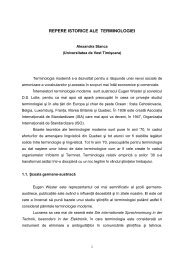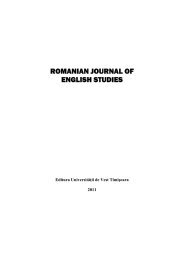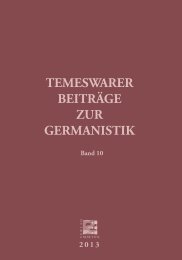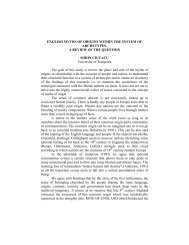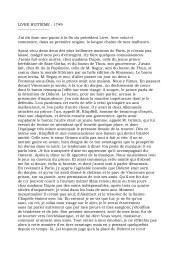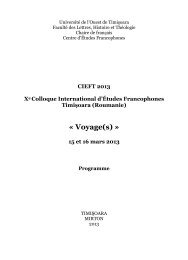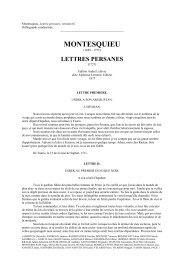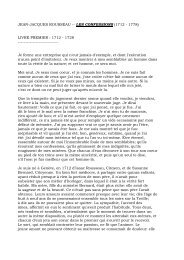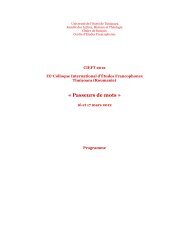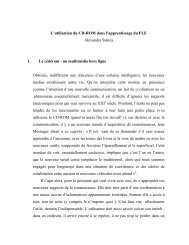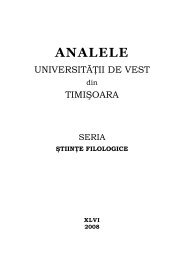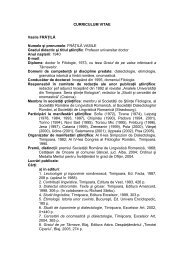TRANSLATION AND MEANING: A CULTURAL- COGNITIVE ...
TRANSLATION AND MEANING: A CULTURAL- COGNITIVE ...
TRANSLATION AND MEANING: A CULTURAL- COGNITIVE ...
You also want an ePaper? Increase the reach of your titles
YUMPU automatically turns print PDFs into web optimized ePapers that Google loves.
endition of the original image: “La geam cu străluciri de foc”. Version 3<br />
ignores the translation of the epithet “brilliant” thus losing one important<br />
stylistical device. Version 4 omits to translate the noun “niche”.<br />
The comparison in the second line, “How statue-like I see thee<br />
stand”, is preserved as an explicit comparison only in versions 2 and 4: “Miapari<br />
ca o statuie nemişcată!” “Te văd ca o statuie stând!”. In versions 1 and<br />
3, the comparison is changed into a metaphor, the first version adding a<br />
second use of the Perfect Simplu tense (the first one appears in the end of<br />
the second stanza and reminds the Romanian reader of Eminescu’s poetic<br />
use of this tense) while the third adds a new element that was not present in<br />
the original, “şi în vânt”. The agate lamp is only described in point of<br />
its being in Helen’s hand, because Poe wanted to suggest various<br />
interpretations: either the burning lamp made the window-niche shine or it<br />
was Helen herself that shone illuminating the “wanderer”. Two Romanian<br />
versions stress the fact that the lamp was burning thus making it more<br />
difficult to get to Poe’s suggestion: “În mână cu lampa de-agată fierbinte”<br />
(version 1), “Ţii lampa de agat, arzând” (version 3). Versions 2 and 4 render<br />
the neuter image of the original. The metaphorical identification of Helen<br />
with Psyche as the one that reveals divinity is made by the second<br />
invocation of the poem, followed by a construction which lacks the verb:<br />
“Psyche, from the regions which / Are Holy Land!” The Romanian versions<br />
1, 3 and 4 found it necessary to use the verb “a veni” or “a sosi” to suggest<br />
Psyche’s origin. “Holy Land” is translated in version 1 by a plural (“Ţări<br />
Sfinte”) thus effacing the idea of unicity. Version 2 is closer to the original<br />
in not using any verb, but it adds a noun phrase in the end, “de jertfă<br />
minunată”, with reference to Biblical sacrificial rituals. Version 3 also adds<br />
“tainic drum”, a detail about the way on which Psyche had come, to stress<br />
the idea of mystery and of abstract voyage in space and time which is at the<br />
basis of the whole poem. Version 4 is closest to the original, the only<br />
change it operates being the translation of the plural “regions” by a singular<br />
“loc” which does not affect the meaning. This last stanza contains emotional<br />
markers represented by two interjections, “Lo” and “Ah” as well as by four<br />
exclamation marks. Versions 1, 2 and 4 preserve only two such marks while<br />
version 3 omits them.<br />
Only two Romanian versions, 2 and 4, render the rhyme pattern of<br />
the poem. Moreover, version 4 succeeds in rendering the rhyming sounds<br />
[or] in the first stanza, symbolical of sadness in Poe’s view. Version 1 uses<br />
the pattern abbab in the first and the last stanza, while the second stanza,<br />
reduced to only four lines, has the pattern abab. Version 3 adopts another<br />
strategy: the pattern ababb in the first and second stanzas and the pattern<br />
abbab in the last stanza. In point of metrical pattern, it is only version 4 that



